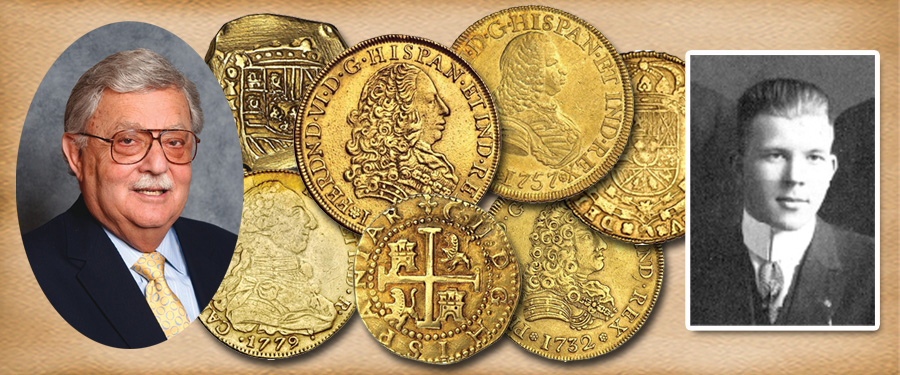
In this article I continue to tell of my visit to
Mr. Lilly’s house in 1958. After we left the Library Wing at Eagle’s Nest I had
the opportunity once again
to look at the other items he had
studied and collected. In special cases
on the wall there was an impressive collection of rifles, and other fighting implements like swords and
bayonets, all from the Revolutionary
period in America. All were is superb condition and could, according to Mr. Lilly, be used, if you knew how to load them. He also showed me some magnificent seascapes, as he loved the lore of the sea.
Mr. Lilly had collected postage stamps through the
years, a collection he started after buying a stamp album and a large assortment of stamps for his grandson and
working together with him to mount them in the albums. He later developed a
major stamp collection of the United States, which had as its highlight a mint perfect example of the 24¢ Inverted Jenny (the stamp was
printed with the airplane
upside down). When the collection was sold in later years it took seven full auction catalogs to present then!
It was indeed a major collection, and a perfect example of how much time and effort he spent on his
hobbies.
He also wanted to own some precious stones, and he displayed to me a wonderful array of
diamonds, emeralds, rubies, and
other colored stones, in various sizes and shapes. Of these items he said, “These are really Mrs. Lilly’s.”
The most outstanding collection he built (although
not as valuable as some of his other accumulations) was his collection of lead soldiers.
Mr. Lilly traced American military units from the
era of the Green
Mountain Boys (pre-revolutionary) up
to World War I. He was interested
in the uniforms each company or regiment wore and researched their dress.
He had small groupings of five to seven of each company, cast to order by the foremost artist of military dress who
worked in Philadelphia and confirmed along with Mr. Lilly the actual uniforms for each grouping. Once they were
cast, each was hand
painted. A group would include a Captain, the officer under him, a foot
soldier, a drummer, and a flag
bearer. Sometimes they would add the bugler or major officer as appropriate.
The total number of lead soldiers on
display was approximately 5,000. Regiments from the different states
varied from each other, especially during the Civil War. The North
wore blue but the ornamentation varied, making the uniforms and decorations
different yet similar. The South wore gray and their uniforms also differed
from regiment to regiment, state to state. With several hundred different
regiments coming to battle from both sides, each from the locality of town, city, and state, the uniforms,
though the same basic color for each side, differed. Therefore, Mr. Lilly,
being a true collector, wanted them all to be correct, so he studied the
designs of each set and the caster of
the lead soldiers followed
through. He also had examples of the Navy and Marines of each period
, with distinctive uniforms of their
own. Hence, 5,000 soldiers, lead
soldiers on display!
Visiting with Mr.
Lilly at Eagle’s Nest and seeing his collections confirmed to me how a dedicated collector approaches his
hobbies. Mr. Lilly’s approach was simple: assemble the best you can, set
your goals, get the knowledge you
need and take advantage of the experience and expertise of others. The result
is then a fine, well-built collection that can someday be passed on to family
members, an institution of learning, or be sold at auction by a reputable
auction house, perhaps a firm that assisted in building the collections.
To me, Mr.
Josiah K. Lilly was a man with a purpose, who made himself remembered in numismatics, philately, and the collecting of rare book
and documents, early colonial rifles,
great pieces of art and statuary, and left a legacy for the future to study and enjoy. In my next article I
will continue with the story of J.K. Lilly’s amazing collection and how Stack’s continued to serve him.





